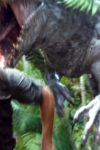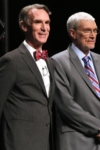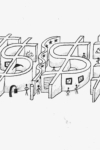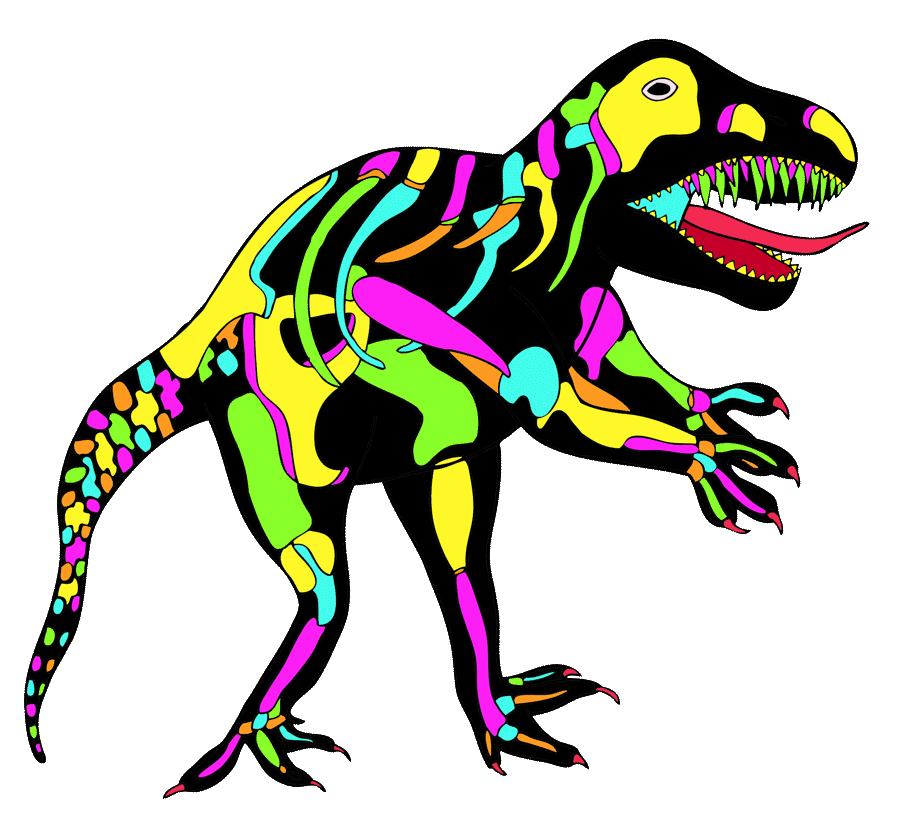
Illustration by Goda Trakumaite
The great failing of all philosophy is its continued refusal to properly consider the question of dinosaurs.
A baffling refusal. They have something to hide. When they don’t talk about dinosaurs it’s because there’s something they’re trying to keep covered up.
Radicals tend to not like dinosaurs very much. They’re big, and clunky, and all of them dead; they bear royal names and privileges, they inspire a politically dubious sense of the sublime. There doesn’t seem to be any real place in our non-alienated future for the dinosaurs. If they mean anything it’s only the ancien regime, a grand and terrible relic of a lost age. We’ll gawp at their bones, but first they must be bones. That’s not the real problem with dinosaurs, though: the reason so many seemingly educated people seem so unwilling to talk about dinosaurs is the uncomfortable feeling that they might somehow come back.
The thing about the repressed is that it always does come back. It’s in a different form, but no number of asteroid impacts can blot out the central law of the psyche. The primal analytic scene is this: a patient, squirming on a couch, saying this and that thing about the problems in her life, trying to avoid the central issue in a constant swerving series of linguistic loops, unavoidably centripetal — suddenly she seizes up. A cough. One hand darts into the air, seized, contorted; already the polished and manicured nails are looking somehow claw-like. When she tries to speak again her mouth opens into a long slit running to the corners of her jaw, revealing the rows of tiny sharp teeth behind. Her face lengthens to a snouty point, her hair frills into soft downy feathers, her ankle travels halfway up her leg. There’s a dinosaur on the couch. Then it speaks — something ultimately quite banal about its parents or its childhood; the point is that it’s something ancestral and inhuman, from the old dark wordless prehistory of the mind. Memory is everywhere a form of bioengineering; the bringing back of a dinosaur.
Faulkner understood it: The past is never dead. It’s not even past. Reintroducing the dinosaurs isn’t a matter of temporal but spatial rearrangement. In cinema, the reanimated dinosaurs always seem to have a particular fury that has nothing to do with hunger. It doesn’t matter if they were hiding out in some isolated valley, or brought back by genetic engineering, or if they infiltrated our world through a rift in the fabric of time, the anger is the same. Dinosaurs attack fences, Portaloos, helicopters, cars. Especially cars: they take particular joy in crushing heavily-built vehicles under one gargantuan foot. When they break into homes, they’ll do their best to shred every manufactured item they find. If they’re ever let out in a built-up area, they’ll immediately get to work systematically destroying skyscrapers. The carnivorous species will, admittedly, sometimes stop to eat a few people — but this always seems like an afterthought, a snack break in their main task of leveling large buildings. In 1953’s The Beast from 20,000 Fathoms, arguably the first dinosaur-in-the-city film and a direct influence on the original Godzilla, the first thing an atomically reanimated Rhedosaurus does on making land in New England is to destroy a lighthouse. It’s not at all concerned with the possible edibility of the lighthouse-keepers; instead, it bites the building itself in half before rearing up over its castrated stump and roaring in primeval victory. In 1956’s The Beast of Hollow Mountain (old science fiction films weren’t named creatively, but the producers knew what worked) the dinosaur sets off a cattle rampage, seemingly deliberately, that all but demolishes a Wild West town, turning the agricultural basis of settled human civilization against itself. As the technological means of reanimating the dinosaurs went from atom bombs and papier-mâché to wormholes, time travel and CGI, soon no city was safe. The dinosaurs themselves came to inhabit every achievement of industrial civilization, whether as the mechanical dinobots that stomp on Hong Kong in Transformers: Age of Extinction or the genetically engineered creatures (explicitly connected with dinosaurs in the film) that threaten half the planet in Pacific Rim. Over the past few years, cinematic culture has come to resemble a series of variations on one single image: a saurian monster pummeling, with all the fury of the unfathomably alien, a mute and motionless office building.
This is strange, because the dinosaurs never seem to have the same antipathy towards geological structures — and it’s hard to imagine how a dinosaur could conceive of a tall building apart from as a geological structure. Clearly it’s not the buildings themselves the dinosaurs object to; it’s the spatial logic that they represent, the system by which we parcel out the topology of existence into named and comprehensible chunks. Dinosaurs are different from other monsters in that they were once here. They’re not invaders from the outside; their claim to this space is better than ours. The place where you’re reading this now is understood to be within some defined area: a privately owned home or office, a neighborhood, a city, a region, a nation-state as symbolized by some patches of color on a square of cloth somewhere, a breakaway territory, an autonomous zone — something by which space is understood. Except it isn’t: you’re standing in the footprints of dinosaurs. Their great herds roamed over this same land, and fought titanic combats, and died in their millions. Over the ground that they walked, human beings have built Ipswitch and Rotterdam and Kansas City, flyovers and business parks and shopping centers. This little patch of soil you know so well was once a strange and terrifying place. Human beings take the remnants of this lost universe, crush them up, and use them to power Hyundais. No wonder dinosaurs hate cars so much: cars are the crematoria we’ve built for our ancestors. In Jurassic Park dinosaurs are treated as the scaly instantiations of a principle of mathematical chaos, but in fact their destruction is a finely premeditated revenge.
Philosophers don’t want to consider dinosaurs because in any epistemology or ontology that follows Kant in featuring a distinction between human experience and the non-human world, dinosaurs represent the ultimate point of the non-human world’s unknowability. God is an indeterminate quantity; the real Absolute Other is twenty-three meters from end to end, with broad flat teeth for slicing up vegetable matter and a long tapering tail that draws lazy circles in the heavy Tithonian air. Levinas and Derrida speak of the unfathomable void of an animal’s eyes, and in a way they’re right; there’s sometimes something briefly terrifying in there. But it’s only a punctum, a sudden pin-prick: we know animals, we see them in the park, we grew up with them in fables and nursery stories. It’s a wound that quickly heals.
Dinosaurs are too big to fit in any of our conceptual categories. If we’re to conceive of a noumenon, a real world as it really is, outside our experience, the previous existence of dinosaurs on the earth is the most important single fact about that world. They stand for the sheer unimportance of human subjectivity: reality was around for millions of years before we arrived to ponder its nature, and it did fine; even without a human subject to give meaning to its objectivity it was still full of life and danger. In this light, the strange refusal to talk about dinosaurs is so pervasive and so consistent that it can only be read as a neurotic symptom. If we don’t discuss them, maybe they won’t come back to claw our fragile distinction from the world of objects into shreds. It’s not just our finely wrought society that the dinosaurs threaten; it’s the idea that human subjectivities and the world beyond them can face each other as two equal halves, evenly matched. It’s the fantasy of an inert world, one without gargantuan teeth. It’s the idea that humans are subjects, always subjects, and always humans.
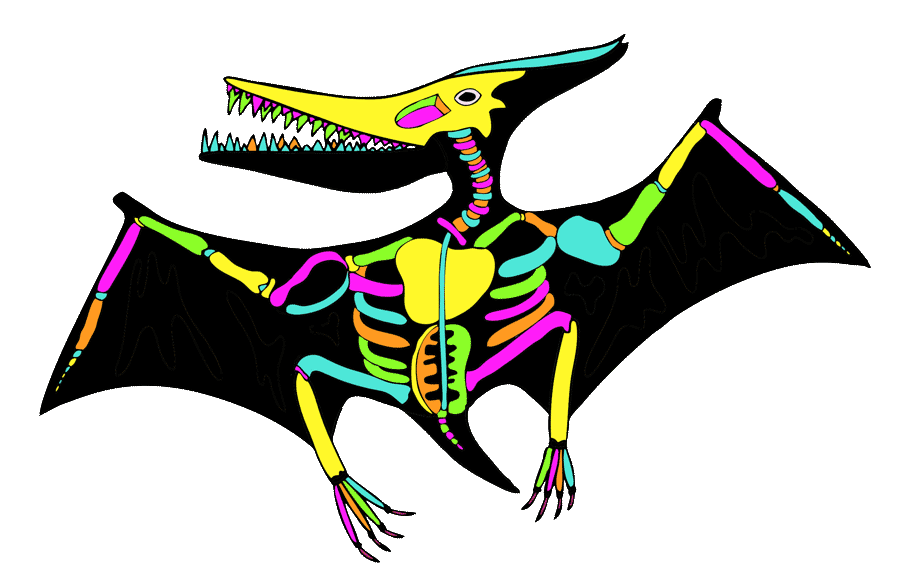
Illustration by Goda Trakumaite
When it comes to the non-human world, philosophers have an unusual tic: they all suddenly start talking about desks. Is the desk really brown, or is its brownness a property of my sense-perception? Is it really made of wood, or is that just informed by discursive practices? Bertrand Russell does it in The Problems of Philosophy. Wittgenstein does it in his Philosophical Investigations. Husserl does it in the first volume of his Ideas. Marx, to his credit, at least has some fun with it while talking about commodity fetishism in Capital; his desk stands on its head, and evolves out of its wooden brain grotesque ideas, far more wonderful than if it were to begin dancing of its own free will. Meanwhile, Heidegger has the full complement: a desk, a pen, and an ink-pot. He also famously uses a hammer, but it’s not the kind of hammer that Nietzsche encourages us to philosophize with, or the kind that one of Heidegger’s distant German ancestors might have used to cave in the skulls of a few Roman legionaries. For Heidegger the non-human world is made of tools; his hammer is an instrument of carpentry, one that you would use to build a desk. All this betrays a critical lack of imagination. Read enough philosophy and you’ll end up with the impression that the entire world is some vast university building, a network of tiny wood-paneled rooms sprawling over the entire surface of the planet, each one containing nothing more than a single desk and a puzzled man trying to figure out his relationship to it. Of course, nobody is watching the philosopher. All these philosophers needed to get out more: searching for an example, they settled on the desk in front of them, when they could have gone down to the museum and looked at the dinosaurs.
This isn’t just a cosmetic point: a desk is not like a dinosaur. Both might be dead objects that were once alive, but unlike the grinning calcified skeletons in the museums, felled trees don’t plot many schemes for revenge. A wooden desk might give you a splinter, but other than that it’s stupidly compliant, happily representing a static world. The faddish recent trend towards object-oriented philosophy, for all its pretensions, does little better. Its central feature is what’s called an ‘anthropodecentrism’; a rejection of any philosophical approach that ascribes some intrinsic difference to the human experience of the world or routes all relations between objects through humans. Objects don’t require a subject; they don’t just have existence in themselves but must too have a being-for-itself. As Graham Harman — its foremost advocate — argues, who are we to say with certitude that a hammer (of course, it’s still a hammer; sometimes a lizard or a piece of fruit, never a dinosaur) doesn’t move knowingly towards its own Being? Why do we malign a banana’s perspective on the world? This sounds like the kind of philosophy that would be able to finally face the dinosaurian core of reality; in fact it does precisely the opposite. They refuse to consider the non-human world as being properly non-human. All they do is execute the same Beauty and the Beast maneuver that Marx does in Capital, but with none of his irony; rather than standing in awe of the inhuman, they have candles and teapots dancing around in a grim pantomime. Rather than resurrect the dinosaurs, they’d have the dinosaurs play at being human.
With all their Lovecraftian references, object-oriented ontologists and speculative realists make a point of stressing the “weirdness” of their philosophical project, but while there’s often an Unheimlich element to the world of lifelike automatons and inorganic demons they claim to inhabit, it’s not necessarily as strange as they insist. Things come to life crop up constantly in popular culture. There’s the Freudian nightmare of the Toy Story films, or worse yet the hellscape of Pixar’s Cars series, in which human-like cars dominate the world, working in factories and offices, with the only reasonable explanation for all this being that long in the film’s past the cars have unshackled themselves from the yoke of humanity and slaughtered every last living person. Maybe the fossilized remains of the people that once built these cars are being used to power their engines. Even dinosaurs are subjected to this logic, with the cutesy talking banalized creatures of The Land Before Time. Object-oriented philosophy isn’t much more than commodity fetishism; Harman’s ‘vicarious causation’ is less a profoundly weird innovation that reveals a hidden truth than the old Marxian analysis of capitalism raised to a universal: material relations between people, social relations between things. Real strangeness isn’t in the vaudeville act of objects perceiving and relating to each other, but a collapse of the human-world distinction that brings out the non-human in humanity.
When the dinosaurs come back, it’s through us. An ancestral statement is ancestral, in our buried history. As any knowledgeable animist will tell you, our ancestors continue to live through us. First there’s the psychoanalytic subject, suddenly seized by a saurian remembrance. When you excavate the buried truth about yourself, all the repressed memories and hidden feelings, you’re no longer fully yourself at all. The bones were always visible, half-poking out through the stony strata (in one of his seminars Lacan remarked that it wouldn’t be a bad thing if every analyst went out and bought a small book on geology), but that person in the past is suddenly revealed as a very different person to the one that remembers, unaccountably attached to a similar body: not bones any more, but a living, breathing, roaring dinosaur.
But in fact this resurrection of the dinosaurs happens all the time. For a start, it’s the basis of the process of material production under capitalism. Workers are, for a few hours each day, entirely subordinated to the process of production; subjectivity takes place on the level of the firm, while actual human beings are interchangeable units slotted carelessly into the assembly-line. Then in their leisure time they’re approached in their role as consumers, subjects again, and sold images of dinosaurs destroying their workplaces with teeth and claws. The point is to resolve our feelings of alienation into the figure of a giant scaly monster, in the hope that the pseudo-catharsis of the dinosaurian revolution onscreen will stop it happening in the streets.
Our task is to not be afraid of dinosaurs, because we are dinosaurs. Any encounter with another person takes place across the void of the Real: you look into their eyes and see the hungry glint of a velociraptor, the utter foreignness of the other’s desire. This is what’s called objectification: the transformation of another person into something entirely unknowable, the brief resurrection of the dinosaurs. A normal philosophy will try to collapse all of humanity into the single figure of a philosopher staring, baffled, at his own desk. (The desk doesn’t stare back.) A figure invariably coded as one that’s probably male and certainly white, a solipsist who stands detached from things, looking at them, resting his chin on one hand. There’s nothing quite so stupid and solipsistic as the insistence that you are exactly what you feel yourself to be. This is perfectly exemplified by Hegel’s famous dialectic of the master and slave. In the Hegelian myth, when two people first encountered each other, they both demand that the other recognize them not as object but as a self-consciousness, a reflective subject. In such an immediate confrontation, this kind of recognition is impossible: in practical terms, what this means is that they both immediately try to club each other to death. The one who is not afraid of death wins, and the other is enslaved. Then, sheltered in the dialectical oasis of Knechtschaft, the slave comes to recognize the master as subject, allowing the relation to progress to a higher form. In the end, full consciousness is reached by both, at the small cost of hundreds of millions of deaths.
There’s another way. The necessary alternative is to fully inhabit your existence as an object, to admit that you too are a dinosaur in the eyes of the other. If humanity is fully represented by the unobserved observer confused by carpentry, or the stupid waltz of master and slave, then none of us are fully human. We are the desk, not the philosopher: at some point always the object of someone else’s puzzled stare. Look at your hands: is that skin you’re seeing, or scales? You are not who you think you are. Once this is recognized, maybe we can turn our mutual inhumanity into a solidarity of the non-human. We can accept that we ourselves are strange and terrifying beasts, and then finally let the fury of the dinosaurs loose.
This post may contain affiliate links.




